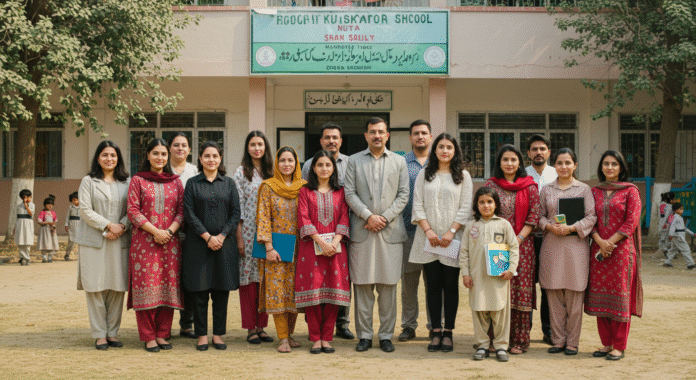Sindh Schools Update highlights how the Sindh government just took an initiative which demonstrates how further streamlining administrative functionalities can add value to teachers and educational personnel, precisely when improved technology is enabling departments to be more productive.
The Sindh Schools Update reveals that the Government of Sindh is now ready to put in place a new policy in which teachers and non-teaching staff members of the School Education Department will be promoted to the next grade. Although this does not sound as ‘newsworthy’ as the other government initiatives, in reality, it is soothing to believe that there exists a policy which addresses the frustration caused by the lack of mobility in the advancement of many staff members.
“Officials have broadly outlined the processes by which the promotion will be executed.” said Directorate of Settlement and Novelties of Education. All regional offices are then required to prepare the so-called seniority lists by October 15. Imagine an automated line consisting of teachers where the promotion train is about to take off and each teacher gets on a specific compartment based on the years of service given.”
Now, you might ask, what does this have to do with doing trends. Well, promotion at this scale needs efficient data handling. Sindh Schools Update explains that there was a time when many of these tasks became slow, cumbersome, and confusing when performed manually and with old systems. However, now the department is capable of managing large employee data faster and with more transparency, thanks to modern systems of digital record keeping and communications.
Picture trying to coordinate a large group assignment with no clear system is a recipe for chaos. It is very easy to miss out on what and when people did things. However, if you have systems that do over time tracking of people, this becomes easy and more equitable. Technology does the same for a staff in the education departments, it does record keeping on staff information, timelines, and decisions real time.
There are many schools in the world, and more by the minute in Sindh, Sindh Schools Update shows that digital tools are making a difference. For instance:
Schools do not have cabinets and piles of paper. They have digital systems and software that enhances the speed of record correction, and promotes to staff faster.
Communication through group chats and messaging systems allows education people to communicate, make updates, and fix things more easily.
The smart apps for performance and attendance ease the process for monitoring as well as attendance for both students and teachers. The smart systems above prompt the process of monitoring students’ attendance and progress. It improves the class learning experience for everybody involved.
The life of a teacher, Aisha, a science teacher at a school in Karachi, faced problems like slow paperwork processing and mistakes in data entry. But then, the new online systems and proper communication channels got set up.
Mrs. Aisha states, “The number of records that I need to finalize and achieve is less, which means that the work I need to do is smoother. Using technology to save time for my students is far greater than having to check stacks of papers.”
Sindh Schools Update highlights that even basic technology, like saved records, can help improve the life of a teacher. It also motivates teachers to work harder.
The passing of promotion is done in different circumstances but still offers less friction. Once the seniority records are validated, the DPC for the students get together and discuss the results of their validations. The DPC is chaired by the School Secretary.
Sindh Schools Update emphasizes that such systems reduce paperwork and increase fairness.
For teachers, whether they are teaching high school subjects such as Math and Science or serving as specialists and for other personnel serving in support roles in schools, these promotions mean recognition and new career prospects. It’s like a video game—with each level you advance, there are new responsibilities and rewards.
In addition to that, it increases enthusiasm and enhances the education sector. Sindh Schools Update demonstrates that when personnel feel their contributions count and there is career advancement, they are more open to bringing fresh motivation and ideas to their job. This in turn improves the education systems in place for students.
These administrative changes are part of a bigger phenomenon: technology is increasingly important in the enhancement and management of educational systems. Technology is being used in schools to ease several tasks such as attendance taking, grading, student health monitoring, and administrative training.
Digital filing systems, for instance, facilitate the storage and instant retrieval of staff training accomplishments, promotions, and records. This helps to eliminate the paperwork that hinders leaders from making faster, informed, and smart decisions. Moreover, the open records foster confidence and trust among teachers, staff, and the entire community.
Sindh Schools Update shows how this transparency builds a culture of accountability and efficiency.
Technology is important in education management because it shows the distribution of technology in a school or community in a simplified manner. As staff promotion is automated and simplified, staff members spend more time teaching rather than worrying about administrative work.
Also, promotion processes decontextualized from unnecessary safes and folders give a clear process to track and manage documents digitally. Sindh Schools Update illustrates how practical tools can make complex processes faster and easier, bringing about transformation and improvement to everyday work.
Promotion processes that reduce unnecessary work and promote increased efficiency can have a positive outcome on Sindh’s education within the upcoming months. Motivated teams, with more varied experience, can add value to schools. Staff members who get promoted during the process of government adoption of tech solutions can gain new service-learning environments and digital tools.
Sindh Schools Update predicts that such advancements will continue improving education delivery across the province.
Promotions or school improvements aren’t about just the school anymore. Think about the bigger picture. Schools and people are more efficient because of technology. Organizing files or building smart classrooms, Sindh Schools Update concludes that technology is reshaping learning and the future of education. This might change your process of learning.



